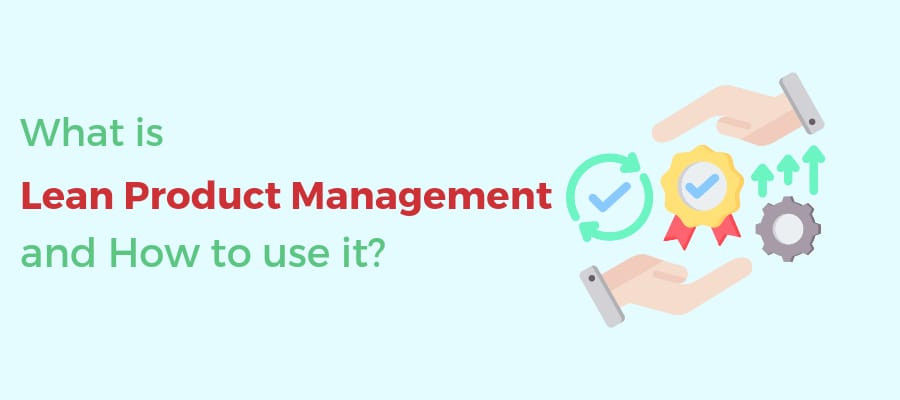What is Lean Product Management and How to use it?

Over the past few years, Lean Product Management has emerged as a popular approach for validating whether an organization's ideas are on the right track. Using customer feedback at every stage of product development and eliminating unnecessary elements, Lean product management is a strategy to fast forward the product launch process for businesses.
To encourage more Product Managers to use this approach within their teams, this post provides a comprehensive overview of what Lean product management entails, how it can improve product management processes, and how it can be leveraged in product design.
What is Lean Product Management?
The potential risk of product failure can be significantly reduced by adopting Lean Product Management, which prioritizes customer feedback and data to inform Product Strategy. Rather than relying on internal requirements, Lean product managers emphasize customer problems. They prefer data-driven experiments over assumptions, customer problem roadmaps over feature roadmaps, and idea generation and collaboration over solution mandates.
Lean Product Management embodies commonly used product management terminologies such as data-driven and voice of the customer and enforces accountability among product managers to adhere to these principles. The product development process can benefit from the structure provided by Lean product management.
Lean Product Management is an approach to product development that emphasizes speed, experimentation, and customer feedback. It is a methodology that aims to minimize waste and maximize value in the product development process.
Adopting the lean approach enables product teams to reduce time to market, maintain focus on critical aspects, use customer feedback, organize the structure and eliminate unnecessary processes, reduce the cost of building the product, and quickly validate hypotheses with a minimum viable product (MVP). These benefits are essential to the successful development and launch of any product, and Lean Product management has become a popular methodology for achieving them.
Why do Lean Product Management matters?
Product Managers play a critical role in bridging the gap between customer needs and the features and updates of a product. However, factors like internal pressures, external stakeholders, and poor management practices hinder their ability to deliver products that customers desire. Product managers sometimes make decisions without fully understanding what customers want, resulting in wasted resources, low satisfaction, and team morale.
Incorporating Lean principles into Product Strategy and development can help address these challenges. Lean product management offers a framework that aligns Product Strategy decisions with company goals, KPIs, and customer needs. It empowers product managers to focus on delivering meaningful work quickly, not just increasing development speed but also increasing velocity or acceleration with direction.
In other words, Lean Product Management is about building the right things at the right time, not just building things. It’s the responsibility of product managers to determine what those "right things" are and ensure that they deliver them to customers.
How to use Lean Product Management?
To implement Lean Product Management as a Product manager, you can gradually introduce poor practices and engage your team to foster a shift towards lean thinking.
Here are some practical activities that can help you apply lean product management in your organization:
- Continuous Market Analysis:
Market analysis should be an ongoing activity throughout the product lifecycle to track changing customer needs and emerging competitors. As a product manager, focus on attaining product-market fit rather than forcing products on the market. Lean product managers understand the importance of slowing down, analyzing product data, and making necessary adjustments before launching a product.
- Business Process Mapping:
Business process mapping is a visual representation of the step-by-step guide to the product development process. Process maps can help showcase the process of bringing a product from ideation to implementation and Release. Continuously evaluate each step of the process to identify opportunities for eliminating, streamlining, or combining tasks to get the product to market faster.
- Value Stream Mapping:
Value stream mapping focuses on driving value to the customer, unlike business process mapping, which is centered on improving processes.
- Lean Startup:
The lean startup process revolves around the build-measure-learn feedback loop. It encourages product-driven organizations to ideate and build an MVP, Release it to the market, measure its performance, and work on the next iteration based on customer feedback.
The aim is to reduce waste, focus on core features, produce a saleable MVP with minimum expense, and continuously iterate while Learning and documenting lessons. Adopting the lean startup process can significantly improve the product development process, minimize risks, and enhance the chances of achieving product-market fit.
Conclusion
The Lean Methodology is not just a buzzword but a practical approach that can significantly benefit Product Management. By embracing lean principles in product development and design, you can optimize your Product Management practices and create products that resonate with your customers.
Through Lean Product Management, you can identify and eliminate inefficiencies, prioritize customer feedback, and deliver value to your customers quickly. By doing so, you can reduce development time and costs, minimize risks, and create products that meet the needs and preferences of your target audience.
Reference
- https://www.eleken.co/blog-posts/understanding-lean-product-management-and-how-its-applied-to-product-design



